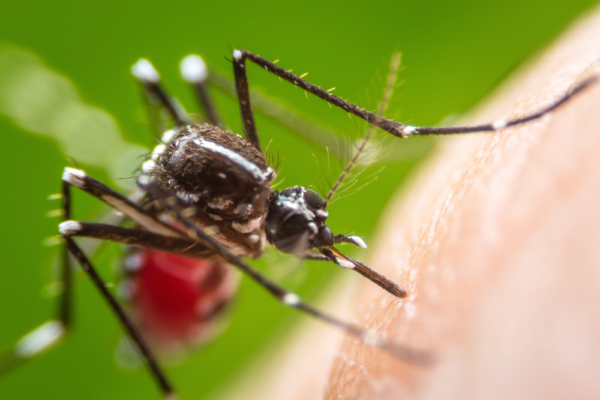Los Angeles, known as the “Movie Capital,” has recently gained another nickname – the “Mosquito Capital.” In recent years, the city has been plagued by an abundance of mosquitoes, particularly targeting people’s exposed ankles, making it difficult to guard against. It has been rated as the city with the most mosquitoes for four consecutive years by the pest control company Orkin.
Mr. Ma, a resident of Los Angeles County, enjoys exercising in the park every morning, but finds himself frequently bitten by a type of mosquito known as “ankle biter.” Although the bites cause temporary itching, it usually subsides quickly. These “ankle biter” mosquitoes could be Egyptian or Asian tiger mosquitoes, known for their preference for low-altitude flights and their tendency to bite ankles, earning them the nickname of “ankle killer” among locals. Besides causing itchy welts on the skin, these mosquitoes can also transmit diseases like West Nile virus, dengue fever, and yellow fever.
Following the discovery of mosquitoes carrying the West Nile virus in the San Fernando Valley area of Los Angeles County in early June, samples collected in Huntington Beach City by the Orange County Mosquito and Vector Control District also revealed the presence of the West Nile virus for the first time this year. According to NBC Los Angeles, Huntington Beach is a hotspot for West Nile virus activity.
As of July 9th, there have been no reported cases of human infection with the West Nile virus in Los Angeles. However, data from the Centers for Disease Control and Prevention (CDC) shows a total of 15 West Nile virus infection cases reported in 11 states across the U.S. this year.
According to the World Health Organization, about 20% of people infected with this virus may develop West Nile fever, which manifests with symptoms like fever, headache, fatigue, nausea, vomiting, muscle aches, and in severe cases, high fever, coma, or seizures.
In comparison to the West Nile virus, dengue fever has seen more cases in the U.S. this year. Florida and New York have reported the highest numbers, with 218 and 143 cases respectively as of July 2nd. California has recorded 40 cases of dengue fever, with Orange County reporting 13 cases. Symptoms of dengue fever include nausea, vomiting, diarrhea, and in severe cases, patients may develop severe complications or even fatalities. Most patients recover on their own, with the elderly and individuals with chronic diseases being at high risk for dengue fever.
According to information from the Greater Los Angeles County Vector Control District website, there are over a dozen mosquito species in the area, including various types of Culex mosquitoes, Asian tiger mosquitoes, and Egyptian mosquitoes.
The reason why Egyptian mosquitoes are dubbed “ankle killers” is because of their preference for low-altitude flights, making exposed ankles a prime target for them. These mosquitoes have a strong reproductive capability, requiring just a small amount of water, such as that found in a bottle cap, for their breeding and growth.
Culex mosquitoes prevalent in the area are capable of transmitting the West Nile virus. These mosquitoes are most active during the early morning and evening when residents are more likely to be outdoors for exercise or relaxation, making them easy targets for mosquito bites.
Orkin’s list of cities with the most mosquitoes in the U.S. for 2024 has Los Angeles at the top spot for the fourth consecutive year. Other California cities like San Francisco, Sacramento, San Diego, and Fresno also make it into the top 50 on the list.
Research indicates that around 20% of the population is more attractive to mosquitoes. According to biomedical scientist Katie McCallum, factors such as the release of carbon dioxide, sweat, body odor, or body temperature could play a role, and individuals who consume beer may also be more prone to attracting mosquitoes.
Blood type may also influence why mosquitoes are more drawn to certain individuals. A study in Japan in 2004 found that mosquitoes were significantly more attracted to individuals with blood type O compared to other blood types, nearly twice as much as blood type A.
The amount of carbon dioxide emitted during breathing can also affect the frequency of mosquito bites. Mosquitoes have sensory cells that can detect the presence of carbon dioxide from over 30 feet away. Adults with larger body sizes and pregnant women emit more carbon dioxide compared to children or smaller individuals, making them more susceptible to mosquito targeting.
Public education plays a crucial role in controlling mosquito breeding. Officials from the Vector Control District recommend that residents ensure there are no leaky outdoor faucets, remove standing water from rain gutters, pots, drains, or any other containers that can hold water for a week, introduce mosquito-eating fish or insecticides in fish ponds, and report neglected pools or drainage areas near their homes to relevant authorities.
Using insect repellents indoors is an effective method to prevent mosquito bites. The CDC suggests using repellents containing DEET, picaridin, IR3535, or lemon eucalyptus oil, which are safe and efficient. For example, applying picaridin repellent on exposed skin can deter mosquitoes, and washing the skin upon returning home is recommended; however, the effectiveness may vary among individuals.
Closing doors and windows at home, installing screens, wearing long-sleeved clothing and long pants when outdoors, and staying away from dark, damp areas where mosquitoes tend to gather are also effective measures to protect family members from mosquito bites.

